M47 Patton
| M47 Patton | |
|---|---|
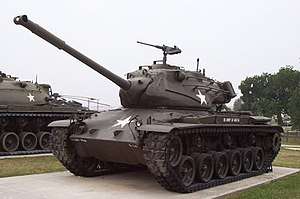 M47 Patton on display | |
| Type | Main battle tank[1] |
| Place of origin | United States |
| Service history | |
| In service | 1952–early 1960s (US) |
| Wars |
Suez Crisis Indo-Pakistani War of 1965 Six-Day War 1971 Indo-Pakistani War Turkish invasion of Cyprus Ogaden War Iran–Iraq War Somali Civil War Yugoslav Wars |
| Production history | |
| Manufacturer |
Detroit Arsenal Tank Plant American Locomotive Co. |
| Produced | 1951–1954 |
| No. built | 8,576 |
| Specifications | |
| Weight | 48.6 short tons (44.1 t) combat ready [2] |
| Length | 27 ft 11 in (8.51 m) |
| Width | 11 ft 6.25 in (3.51 m) |
| Height | 11 ft (3.35 m) |
| Crew | 5 (commander, gunner, loader, driver, assistant driver) |
|
| |
| Armor |
Upper Glacis: 4 in (100 mm) at 60° = 8 in (200 mm) LoS Turret Front: 4 in (100 mm) at 40° = 5.22 in (133 mm) LoS[3] |
Main armament |
90 mm gun M36 71 rounds |
Secondary armament |
1 × .50 cal (12.7 mm) M2 machine gun (roof-mounted)[2] 2 x .30 cal (7.62 mm) M1919A4 machine gun (one flexible mount at right front of hull, one coaxial with the 90mm cannon)[2] |
| Engine |
Continental AV-1790-5B V12, air-cooled, Twin-turbo gasoline engine 810 hp (600 kW) |
| Power/weight | 17.6 hp (13.6 kW) / tonne |
| Transmission | General Motors CD-850-4, 2 ranges forward, 1 reverse |
| Suspension | Torsion bar suspension |
| Fuel capacity | 233 US gal (880 l; 194 imp gal)[2] |
Operational range | 100 mi (160 km)(In average conditions)[2] |
| Speed | 30 mph (48 km/h)[2] |
The M47 Patton was an American main battle tank, a development of the M46 Patton mounting an updated turret, and was in turn further developed as the M48 Patton. It was the second American tank to be named after General George S. Patton, commander of the U.S. Third Army during World War II and one of the earliest American advocates of tanks in battle.
The M47 was the U.S. Army's and Marine Corps' primary tank, intended to replace the M26 Pershing and M46 Patton medium tanks.[note 1] The M47 was widely used by U.S. Cold War allies, both SEATO and NATO countries, and was the only Patton series tank that never saw combat while in US service.
Although similar in appearance to the later M48s and M60s, these were completely new tank designs. Many different M47 Patton models remain in service internationally. The M47 was the last US tank to have a bow-mounted machine gun in the hull.
Design
Although a new power plant corrected the mobility and reliability problems of the M26 Pershing, the subsequently renamed M46 was considered a stopgap solution that would be replaced later by the T42 medium tank. However, after fighting erupted in Korea, the Army decided that it needed the new tank earlier than planned. It was deemed that there was not enough time to finish the development of the T42. The final decision was to produce another interim solution, with the turret of the T42 mounted on the existing M46 hull. Although this interim tank was itself technically immature, Army officials felt the improvements over the M46 in firepower and armor were worth the risk.[4] The composite tank, developed by the Detroit Arsenal, was named the M47 Patton.
In December 1950 the Army awarded a $100 million contract to the American Locomotive Company for the production of 500 tanks.[5] It entered production in 1951. Its main gun was the M36 90 mm gun with an M12 optical rangefinder fitted. The secondary armament consisted of two .30 cal Browning machine guns, one in the bow and one coaxial with the 90mm main gun in the turret, and a .50 caliber Browning M2 on a pintle mount on the turret roof. The M47 was the last American-designed tank to include a bow machine gun. The T42 turret had a larger turret ring than the M26/M46 turret, and featured a needle-nose design, which improved armor protection of the turret front, an elongated turret bustle and storage bin which protruded halfway across the engine deck, and sloped sides to further improve ballistic protection; this gave the turret a decidedly lozenge-shaped profile. It also featured the M12 stereoscopic rangefinder, which was designed to improve first-round hit probability but proved difficult to use; the rangefinder protruded from both sides of the upper turret front, which would be a feature of American tanks until the advent of the M1 Abrams in 1980.[6]
Production at American Locomotive began in July 1951.[7] Logistical and technical issues plagued production almost from the start.
Truman administration policy sought to strengthen American arms makers' resilience to aerial attack by encouraging more decentralized weapons production — away from Detroit. The U.S. curtailed civilian automobile production to boost military production with the onset of the Korean War. As a result Detroit's newly unemployed automotive workers found little work, while tank manufacturers outside Michigan lacked skilled workers. Truman's policy also counted on civilian factories being able to quickly transition to war-time production. However many factories lacked needed tank production machinery, done away with during World War II demobilization.[8]
A faulty Ordnance Corps-designed hydraulic turret-control mechanism, shared by the M41 Walker Bulldog, kept the tanks from Korea while engineers worked on a fix.[8] Engineers improved production quality controls of the hydraulics by April 1952, and set about correcting M47s sidelined in storage. By then Army officials had scrapped plans to send the tanks to Korea, in favor of providing them to troops stationed in Europe and at home.[9]
The first M47s were not fielded to the 1st and 2nd Armored Divisions until summer 1952. Standardized in May 1952, the M47 Patton's production ran until November 1953; Detroit built 5,481 tanks, and American Locomotive Company (Alco) produced 3,095, for a total production run of 8576 M47 Pattons.[10]
Deployment
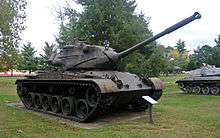
After the U.S. Army in Germany was equipped with the M47, the first M47s delivered under the Mutual Security Agency program were delivered to Belgium in June 1952.[11] In October the agency announced that NATO member nations had agreed to adopt the Chieftain main battle tank and the M47 as standard.[12] By October the At Camp Drum in July, the New Jersey Army National Guard was the first reserve force to train with the tank.[13]
The Marine Corps also fielded M47s starting in late 1952; after the Korean War, all seven Marine tank battalions, three divisional, two reserve training, and two force level, each fielded M47s. But these were soon replaced with M48A1 Pattons and M103 heavy tanks, with the last M47s being retired in 1959.[14]
American Locomotive production was halted in October when the company's ordnance and locomotive divisions went on strike. Production resumed in February when union leaders agreed to a pay raise.[15] In December 1952 the Defense Department ordered cutbacks to M47 and M48 tank production.[16] In November 1953 American Locomotive halted production of the M47 after operators found drive gear defects in Europe.[17] Army officials quickly acknowledged the issue arose from their own expedient decision to use lower grades of steel to circumvent wartime shortages.[18] Chrysler laid off about 1000 workers at Detroit Tank Arsenal when it wrapped up production in November.[19] American Locomotive resumed production in November.[20] The company closed its tank division in June 1954.[21]
With the arrival of the improved M48 Patton in 1953, the M47 was declared "limited standard" in 1955, and examples in tank units were replaced with the M48 series before long.[22] After being declared obsolete in 1957, M46s and M47s were retained in active duty infantry division battlegroup assault gun platoons (four tanks each, one platoon per battlegroup, for a total of 20 tanks per division) until replaced with the light truck-mounted SS-10 anti-tank guided missile in the early 1960s.[23] M47s were used by the Reserves for a relatively short time, soon being replaced by early production M48 Patton series tanks; thus, most of the M47s were exported in the late 1950s.[22][24]
The M47 was widely used by many countries, especially NATO and SEATO allies, including Austria (147), Belgium (784), Ethiopia (30), France (856), Greece (396), [25] from USA and West Germany), Iran (around 400), Italy (2,480), Japan (1 for evaluation only), Jordan (49), Pakistan (100), Portugal (161), Saudi Arabia (23 from the US, 108 on the international market), Somalia (25 from Saudi Arabia), South Korea (531), Sudan (17 from Saudi Arabia), Spain (389), Switzerland (2 for evaluation), Turkey (1,347 from the US and West Germany), West Germany (1,120), and Yugoslavia (319).[26] Like the US Army of the time, the West German Bundeswehr also used some of their M47s as interim tank destroyers/assault guns until replaced by the Raketenjagdpanzer 1 tank destroyers armed with SS-11 anti-tank guided missiles in the early 1960s.[27]
U.S. Army M47s remaining in storage were expended as targets. In the 1970s, they were used for the M60A1's 105mm gun with devastating effect. The 105 mm HEAT round would penetrate the frontal armor with ease. Many M47s in like-new condition met their fate in this manner, showing the M60 crews first hand the effects of modern tank weapons on conventional steel armor.
Combat service
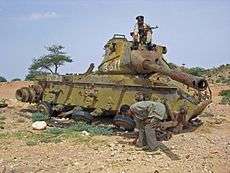
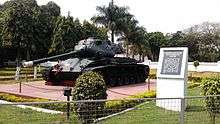
- Pakistan fielded M47s against India in both the Indo-Pakistani War of 1965 and Indo-Pakistani War of 1971.
- Jordan used M47s against Israel in the Six-Day War in 1967.
- The M47 was used by the Turkish Army in the Turkish invasion of Cyprus between July and August of 1974, with an estimated 200 Patton tanks involved in the combat action. At least one operational M47, Serial Number 092273, was captured by the Cyprus National Guard and remained in their service until 1993. This example is currently stored at the camp of the 25 ΕΜΑ in Paphos for use as a training and a war-memorial exhibit.[28]
- Iran sent their M47s to fight against Iraq in the Iran–Iraq War between 1980 to 1988. Iranian M47s performed very poorly against much-superior Iraqi tanks such as T-54s, T-55s, T-62s and T-72s. Large numbers of M47 Patton tanks fell into Iraqi capture by the end of the war.[29]
- In the 1980s and up to the early 1990s, the Turkish Army used M47 tanks against PKK guerrillas within Turkey and neighbouring Iraq. Turkish M48A5 variants replaced all remaining M47s by the late 1990s.
- Croatia used M47s against their Serbian enemies in the Croatian War of Independence but their performance was regarded as inferior to that of the Soviet-designed T-55. The M47s were retired from service immediately after the war and are now used as gunnery/missile live-firing targets during military exercises.
- In the Somali Civil War, some of the country's large M47 collection (obtained prior to the war) may have seen some service in the initial stages of the internal conflict but these aging vehicles soon ceased operations (and left abandoned and/or destroyed) due to a lack of spare parts and proper maintenance by the Somali Army.
- France deployed a squadron of its M47s against Egypt during the Suez Crisis in 1956.
Variants
- M46E1 – pilot model, M46 hull with T42 turret, fitted with the M36 90 mm Gun, and was longer to incorporate a radio, ventilator, and featured a stereoscopic rangefinder; only one built[30]
- M47 – main production version, M46 hull modified with redesigned glacis, reduction from five to three track return rollers per side, longer mufflers on rear fenders; 8,576 built[31]
- M47M – The product of an improvement program started in the late 1960s, the M47M featured the engine and fire control elements from the M60A1. The assistant driver's position was eliminated in favor of additional 90 mm ammunition. Not used by the US; over 800 vehicles were produced for Iran and Pakistan[32]
- M47E – Spanish M47M austere version (kept original FCS).
- M47E1 – Second Spanish upgrade batch with rearranged main gun ammunition storage and crew heater. Both new and upgraded M47Es. 330 converted.
- M47E2 – 45 built. M47E1 with Rh-105 105 mm gun and improved FCS (still electromechanical). Passive night vision for driver and commander. All M47 series MBT in Spanish service retired 1993.
- M47ER3 – Spanish armored recovery vehicle. 22 built.
- Sabalan – An Iranian upgraded version of the US M47M, It has side skirts and a newly built turret fitted with a 105-mm gun, laser range finder, new fire control system and communication equipment.[33][34] Never used in active service.[35]
Additional equipment
- M6 – Earth Moving Tank Mounting Bulldozer. Bulldozer kit for the M47 series.
- Unknown name - Switching 90mm M36 to 90mm M41 which used by M48 Patton III.
Operators
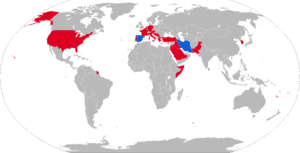
Current operators
Former operators
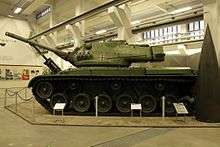
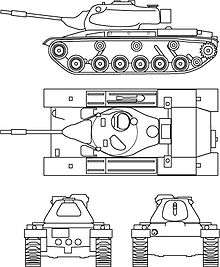

.svg.png)


















.svg.png)
Evaluation only operators

Civilian operators

See also
- T-54 – Soviet tank
- M26 Pershing
- M46 Patton
- M48 Patton
- Type 61
- M60 Patton
- List of armoured fighting vehicles
- M103 (heavy tank)
- G-numbers SNL G262
Notes
- ↑ although the Ordnance Committee Minutes/OCM #33476 ceased utilizing the heavy, medium, and light tank designations on 7 November 1950; going to the "...Gun Tank designation")
References
- ↑ Hunnicutt, p. 35
- 1 2 3 4 5 6 Department of the Army and the Air Force. Military Vehicles (Ordnance Corps Responsibility). Department of the Army Technical Manual, 1953, February 1953 p. 119.
- ↑ Hunnicutt, R.P. (1984). Patton: A History of the American MBT. Presidio. p. 425.
- ↑ Abel, Elie (7 January 1952). "Defective Tanks Pile Up In Depots; Rushed Into Production, New Models Show Turret Flaws And Are Kept From Korea". The New York Times. Retrieved 17 September 2018.
- ↑ "500 Medium Tanks Ordered By Army". The New York Times. UP. 6 December 1950. Retrieved 17 September 2018.
- ↑ Jim Mesko "Pershing/Patton in action" ISBN 0-89747-442-2 pp. 41-45.
- ↑ "Production Line Is Shown". The New York Times. 16 April 1951. Retrieved 17 September 2018.
- 1 2 Abel, Elie (6 January 1951). "Tank Output Lags 6 Months; 2 New Types Unacceptable". The New York Times. Retrieved 17 September 2018.
- ↑ Abel, Elie (17 April 1952). "Army Wins Gamble With Medium Tank; Accepts 48-ton M-47". The New York Times. Retrieved 17 September 2018.
- ↑ Mesko, p. 41.
- ↑ "Belgium Gets First U.S. Tanks". The New York Times. 28 June 1952. Retrieved 17 September 2018.
- ↑ Sulzberger, C. L. (12 October 1952). "Many NATO Arms Are Standardized". The New York Times.
- ↑ "Camp Drum Receives M-47 Medium Tanks". The New York Times. 9 July 1952. Retrieved 17 September 2018.
- ↑ George F. Hofmann and Donn A. Starry "Camp Colt to Desert Storm: The History of U.S. Armored Forces" ISBN 0-8131-2130-2 p. 281.
- ↑ "Union Accepts Pay Raise". The New York Times. UP. 27 February 1953. Retrieved 17 September 2018.
- ↑ "'Stretch Out' Cuts Tank, Truck Output". The New York Times. 9 December 1952. Retrieved 17 September 2018.
- ↑ "Faults Halt Work On Army M-47 Tank". The New York Times. AP. 21 November 1953. Retrieved 17 September 2018.
- ↑ "Tank Gear Failure Explained By Army". The New York Times. AP. 23 November 1953. Retrieved 17 September 2018.
- ↑ "Chrysler To Drop 1000; Slash Due This Month As Army Tank Contract Ends". The New York Times. 3 November 1953. Retrieved 17 September 2018.
- ↑ "Tank Output To Resume; Mechanical Trouble Had Halted Production at Schenectady". The New York Times. UP. 26 November 1953. Retrieved 20 September 2018.
- ↑ "Production Scope Widened by ALCO". The New York Times. 28 December 1954. Retrieved 20 September 2018.
- 1 2 Mesko, p. 47.
- ↑ Department of the Army, "Field Manual FM 7-21 Headquarters and Headquarters Company Infantry Division Battle Group", 8 August 1957, pp. 185, 205.
- ↑ Steven J. Zaloga "The M47 and M48 Patton Tanks" ISBN 1-85532-825-9 pp. 6, 12-38, 44-45.
- ↑ <Hellenic Army General Staff / Training Directorate (Γενικό Επιτελείο Στρατού / Διεύθυνση Εκπαιδεύσεως), History of Cavalry and Tank Corps (Ιστορία Ιππικού Τεθωρακισμένων), Athens (Αθήνα), 1995, pages A9-A13. Also page 58: beginning in 1992 the Greek army scrapped 391 M47 as part of the CFE agreement
- ↑ Zaloga, ibid.
- ↑ Peter Blume, "Die Anfangsjahre des Heeres 1956-1966", Tankograd Publishing 2003, pp. 46-47.
- ↑ The Action of the Captured M47 in Attila II in The Unknown Soldier of Cyprus (Savvas Vlassis) 1997
- ↑ "Американский танк 50-х годов получил шанс на новую жизнь". warfiles.ru. Retrieved 13 February 2015.
- ↑ Mesko, pp. 41, 43
- ↑ Mesko, p. 41
- ↑ Mesko, pp. 41, 43, 45
- 1 2 ARG. "Sabalan Main Battle Tank - Military-Today.com". www.military-today.com. Retrieved 4 April 2018.
- ↑ "بازگشت مقتدرانه قدیمیترین تانک ایرانی پس از 60 سال +عکس". Retrieved 13 February 2015.
- ↑ http://www.washingtoninstitute.org/policy-analysis/view/iran-may-be-renewing-its-interest-in-armored-warfare
- ↑ Abrahamian, Ervand (21 July 1982). "Iran Between Two Revolutions". Princeton University Press. Retrieved 4 April 2018 – via Google Books.
- ↑ Ivan Bajlo. "M-47 Patton". Retrieved 13 February 2015.
- ↑ "Trade Registers", Armstrade.sipri.org. Retrieved 2018-06-11.
- ↑ Hunnicutt, p. 75
- 1 2 "M47 Patton II". Military Factory. Retrieved 7 May 2015.
- ↑ John Pike. "Pakistan Army Equipment". Retrieved 13 February 2015.
- ↑ "M47 (Patton II) Medium Tank (1951)". Militaryfactory.com. Retrieved 1 January 2016.
- ↑ カマド「社長の小部屋」web版,2010-08「中田商店コレクション」(k-m-d Co.,Ltd.owner's blog|2010-08|"Nakata-shouten's Collection")accessdate:2017-12-03
- ↑ Matt McDaniel. "Arnold Schwarzenegger takes his own personal tank out for a spin". Retrieved 3 March 2015.
Bibliography
- Hunnicutt, R. P. "Patton: A History of the American Main Battle Tank." (Vol 1), 1984, Presidio Press; ISBN 0-89141-230-1.
External links
| Wikimedia Commons has media related to M47 tanks. |
- AFV Database: M47 Patton
- GlobalSecurity.org: M47 Patton
- Patton-Mania
- M47 Photos and Walk Arounds on Prime Portal
- "Army's Latest Medium Tank Features Lethal Firepower." Popular Mechanics, June 1952, p. 88. early public relation article for M-47.